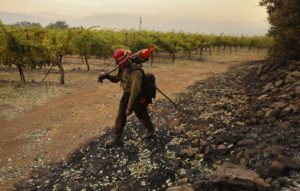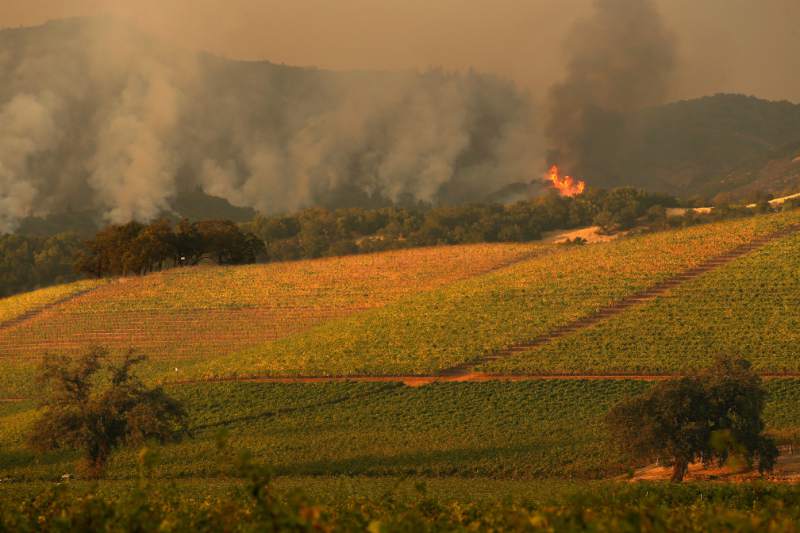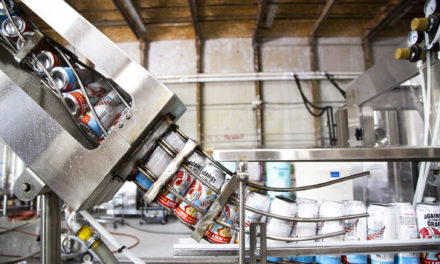
PatRick Corp. firefighter Josh Korczak checks for any signs of heat from a burned area next to a block of Cabernet vines at Kunde Family Winery. [Photo by Christopher Chung]
Luckily, it’s estimated that more than 90 percent of winegrapes were picked before fires broke out on October 8 in Sonoma, Napa, and Mendocino counties. “Overall, it was a great year for wine,” says David Sundberg, winemaker for Hans Fahden Vineyards and Tedeschi Family Winery, both located in Calistoga, Calif. “Really, only a little bit of the stock was affected by the fires.”
According to Remi Cohen, vice president and general manager of Cliff Lede Vineyards in the Stags Leap District of Napa Valley, the Northern California fires should have a minimal impact on future wine quality. “Many grapes were already harvested, because 2017 was a pretty warm year,” says Cohen. The eastern edge of Cliff Lede Vineyards’ Poetry Vineyard was an end line for the Atlas Fire, which burned more than 51,500 acres in Napa County.
“Any vines that were exposed to smoke won’t be affected. Some of the vines in the line of fire on the edges of the vineyard blocks died. They will need to be replanted,” says Cohen.
Assessing the damage
There isn’t a clear answer as to how much of the 2017 harvest was affected, but Jim Lapsley, researcher at the Agricultural Issues Center at UC Davis, says number crunching gave him a clue: “The three-year average yield in Napa County of tons of all grapes was about 151,000 tons. Assuming 10 percent—or 15,100 tons—wasn’t harvested [before the fire] and was all Cabernet Sauvignon, Napa’s three-year average Cabernet harvest was 63,205 tons, so the hypothetical 15,100 tons would represent about 24 percent of Napa’s Cabernet harvest.”
Cabernet Sauvignon grapes, which are often picked later, were most heavily affected. Growers salvaged affected grapes in many ways, starting with “excluding all leaf material, washing all the grapes of smoke ash, and maintaining the integrity of the harvested fruit,” says Stephens Moody, winemaker for Matthew Bruno in Rutherford (Napa County) and president of Granel Bulk Wine and Concentrates in Santa Rosa (Sonoma County), who also advises avoiding maceration and long skin contact.
Some growers treating affected wines are reluctant to disclose they’ve had to discard products, he continues, because of the possible stigma. “Wineries don’t want to be branded with the term ‘smoke taint,’” says Moody. “It’s a scarlet letter.”
Long-term effects

Michael Haney, Sonoma County Vintners
Michael Haney, interim executive director for Sonoma County Vintners, says showcasing non-affected wines has already played a major role in dispelling concerns. “The idea that smoke taint affected this year’s harvest has been inflated,” he says. “To counter those rumors, we’ve done local, regional, national, and international advertising campaigns.”
Through the fall and early winter, wine filtration companies such as Mavrik North America (located in Sonoma County) stayed busy helping wineries restart stuck fermentations, often a result of having no access to the wine for several days during evacuations. Dr. Robert Kreisher, president of Mavrik, says his company recommends evaluating and treating wines for smoke taint when they’re almost ready to bottle, using a variety of methods, including microfiltration and reverse osmosis.
“What we saw this time, as opposed to the 2008 fires in Mendocino County, were fires that were much more intense but of a much shorter duration. In 2008, we saw up to 212 parts per billion [of guaiacol, a universally recognized marker of smoke taint]. This year, it’s in the 4 to 8 parts per billion range that we’re seeing so far,” says Kreisher.
The sensory threshold is cited as 0.5 parts per billion. But, says Moody, even if the numbers are low, no buyers are interested in smoke-tainted grapes.
Remediation and recovery
Smoke-tainted wines can be sold as bulk for California blends or be repurposed (as vinegar, for example). After losing her entire library of wines (as well as most of her current aging vintages) in a massive Vallejo, Calif., warehouse fire in 2005, winemaker Julie Johnson created the Tres Sabores 2004 Fire Roasted Zinfandel Sauce to rescue what she could from the ashes.
 Depending on the level of smoke, winemakers will keep a watchful eye on how new vintages pass muster with critics and consumers. “Smoke taint may have a wild effect on the market,” says Robert Eyler, professor of economics and dean of the school of extended and international education at Sonoma State University in California. “Some people may actually like the smoke depending on how it’s blended. A lot of thought, science, and remediation is going to come from winemaker magic in the winery.”
Depending on the level of smoke, winemakers will keep a watchful eye on how new vintages pass muster with critics and consumers. “Smoke taint may have a wild effect on the market,” says Robert Eyler, professor of economics and dean of the school of extended and international education at Sonoma State University in California. “Some people may actually like the smoke depending on how it’s blended. A lot of thought, science, and remediation is going to come from winemaker magic in the winery.”
As these wines mature, frequent tastings and analysis will help winemakers avoid “ashtray flavor,” yet sometimes, even after remediation efforts, smoke taint can return—though it’s not exactly clear why this occurs.
Eric Dahlberg, president of American Winesecrets LLC in Sebastopol, Calif., says it’s still too early to determine whether the smoke will have a significant impact on 2017 red wines. “We usually know two months after lactic fermentation is complete,” he says, adding that there’s a benefit to treatment. “Smoke taint has a masking effect. Taking that away lets the fruit come out.”
It remains to be seen how the 2017 fires will affect yields and quality this year. Some vineyards must still be cleared of burned material, growers must tend to damaged vines, and questions remain as to whether burned vines will impart a smoky taste to the next crop. As California moves to recovery mode, the state’s wine industry will continue reassuring consumers of its commitment to release only the finest products possible.











